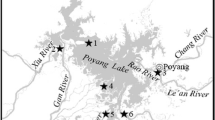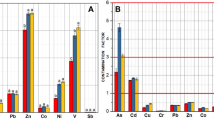Abstract
Global industrialization is a major cause of effluent discharge from industries up to alarming concentrations. Especially, uranium concentrations in water bodies are of great concern, as its radioactivity significantly affects the persistent diversity of microbiota. Recently, continuous application of pesticides in the agricultural lands and accumulation of quartz that enter the Cauvery River has significantly increased the concentration of uranium (U) and other heavy metals. To perceive the impact of uranium on bacterial diversity in Cauvery River, sediment samples collected from polluted (UP) site with 32.4 Bq/K of U concentration and control (UNP) site were scrutinized for bacterial diversity through metagenomic analysis of the V3 region of 16S rDNA by Illumina sequencing. Taxonomic assignment revealed that the unpolluted sample was dominated by Bacteroidetes (27.7 %), and Firmicutes (25.9 %), while sediment sample from the highly polluted site revealed abundance of Proteobacteria (47.5 %) followed by Bacteroidetes (22.4 %) and Firmicutes (14.6 %). Among Proteobacteria, Gammaproteobacteria was the most prevalent group followed by alpha, delta, epsilon, and beta in the uranium-polluted sample. Rare and abundant species analysis revealed that species like Idiomarina loihiensis was abundant in the pollutant sample; however, it was rare (<0.1 %) in the sample from pristine environment. Similarly, the species distribution in both the samples varied, with the bacteria potentially active in redox activity and biosorption potential dominating in the polluted sample. Outcomes of the present study demonstrated the impact of uranium and metal accumulation on the bacterial communities and further confirmed the promising candidature of specific bacterial species as bioindicators of contamination.





Similar content being viewed by others
References
Acosta-Gonzalez A, Rossello-Mora R, Marques S (2013) Characterization of the anaerobic microbial community in oil-polluted subtidal sediments: aromatic biodegradation potential after the prestige oil spill. Environ Microbiol 15:77–92. doi:10.1111/j.1462-2920.2012.02782.x
Aiking H, Stijnman A, van Garderen C, van Heerikhuizen H, van’t Riet J (1984) Inorganic phosphate accumulation and cadmium detoxification in Klebsiella aerogenes NCTC 418 growing in continuous culture. Appl Environ Microbiol 47:374–377
Amann RI, Ludwig W, Schleifer KH (1995) Phylogenetic identification and in situ detection of individual microbial cells without cultivation. Microbiol Rev 59:143–169
Aravindraja C, Viszwapriya D, Karutha Pandian S (2013) Ultradeep 16S rRNA sequencing analysis of geographically similar but diverse unexplored marine samples reveal varied bacterial community composition. PLoS One 8:e76724. doi:10.1371/journal.pone.0076724
Bartram AK, Lynch MD, Stearns JC, Moreno-Hagelsieb G, Neufeld JD (2011) Generation of multimillion-sequence 16S rRNA gene libraries from complex microbial communities by assembling paired-end Illumina reads. Appl Environ Microbiol 77:3846–3852. doi:10.1128/AEM.02772-10
Caetano AL, Marques CR, Gavina A, Carvalho F, Goncalves F, da Silva EF, Pereira R (2014) Contribution for the derivation of a soil screening value (SSV) for uranium, using a natural reference soil. PLoS One 9:e108041. doi:10.1371/journal.pone.0108041
Caporaso JG, Lauber CL, Walters WA, Berg-Lyons D, Lozupone CA, Turnbaugh PJ, Fierer N, Knight R (2011) Global patterns of 16S rRNA diversity at a depth of millions of sequences per sample. Proc Natl Acad Sci USA 108(Suppl 1):4516–4522. doi:10.1073/pnas.1000080107
Cardenas E, Wu WM, Leigh MB, Carley J, Carroll S, Gentry T, Luo J, Watson D, Gu B, Ginder-Vogel M, Kitanidis PK, Jardine PM, Zhou J, Criddle CS, Marsh TL, Tiedje JM (2010) Significant association between sulfate-reducing bacteria and uranium-reducing microbial communities as revealed by a combined massively parallel sequencing-indicator species approach. Appl Environ Microbiol 76:6778–6786
Degnan PH, Ochman H (2012) Illumina-based analysis of microbial community diversity. ISME J 6:183–194. doi:10.1038/ismej.2011.74
Dhal PK, Islam E, Kazy SK, Sar P (2011) Culture-independent molecular analysis of bacterial diversity in uranium-ore/-mine waste-contaminated and non-contaminated sites from uranium mines. 3 Biotech 1:261–272. doi:10.1007/s13205-011-0034-4
Ellis RJ, Morgan P, Weightman AJ, Fry JC (2003) Cultivation-dependent and -independent approaches for determining bacterial diversity in heavy-metal-contaminated soil. Appl Environ Microbiol 69:3223–3230
Faldu PR, Kothari VV, Kothari CR, Rawal CM, Domadia KK, Patel PA, Bhimani HD, Raval VH, Parmar NR, Nathani NM, Koringa PG, Joshi CG, Kothari RK (2014) Draft genome sequence of textile azo dye decolorizing and degrading Pseudomonas aeruginosa strain PFK10, isolated from the common effluent treatment plant of the Ankleshwar industrial area of Gujarat, India. Genome announc 2:e00019–e00014
Gao W, Francis AJ (2008) Reduction of uranium(VI) to uranium(IV) by Clostridia. Appl Environ Microbiol 74:4580–4584. doi:10.1128/AEM.00239-08
Gloor GB, Hummelen R, Macklaim JM, Dickson RJ, Fernandes AD, MacPhee R, Reid G (2010) Microbiome profiling by Illumina sequencing of combinatorial sequence-tagged PCR products. PLoS One 5:e15406. doi:10.1371/journal.pone.0015406
Golebiewski M, Deja-Sikora E, Cichosz M, Tretyn A, Wrobel B (2014) 16S rDNA pyrosequencing analysis of bacterial community in heavy metals polluted soils. Microb Ecol 67:635–647. doi:10.1007/s00248-013-0344-7
Hemme CL, Deng Y, Gentry TJ, Fields MW, Wu L, Barua S, Barry K, Tringe SG, Watson DB, He Z, Hazen TC, Tiedje JM, Rubin EM, Zhou J (2010) Metagenomic insights into evolution of a heavy metal-contaminated groundwater microbial community. The ISME Journal 4:660–672
Hernandez-Raquet G, Budzinski H, Caumette P, Dabert P, Le Menach K, Muyzer G, Duran R (2006) Molecular diversity studies of bacterial communities of oil polluted microbial mats from the Etang de Berre (France). FEMS Microbiol Ecol 58:550–562. doi:10.1111/j.1574-6941.2006.00187.x
Hong SH, Bunge J, Jeon SO, Epstein SS (2006) Predicting microbial species richness. Proc Natl Acad Sci U S A 103:117–122. doi:10.1073/pnas.0507245102
Islam E, Sar P (2011) Molecular assessment on impact of uranium ore contamination in soil bacterial diversity. Int Bioterioration Biodegradation 65:1043–1051
Janssen PH (2006) Identifying the dominant soil bacterial taxa in libraries of 16S rRNA and 16S rRNA genes. Appl Environ Microbiol 72:1719–1728. doi:10.1128/AEM.72.3.1719-1728.2006
Jiang YX, Wu JG, Yu KQ, Ai CX, Zou F, Zhou HW (2011) Integrated lysis procedures reduce extraction biases of microbial DNA from mangrove sediment. J Biosci Bioeng 111:153–157. doi:10.1016/j.jbiosc.2010.10.006
Junier P, Frutschi M, Wigginton NS, Schofield EJ, Bargar JR, Bernier-Latmani R (2009) Metal reduction by spores of Desulfotomaculum reducens. Environ Microbiol 11:3007–3017. doi:10.1111/j.1462-2920.2009.02003.x
Kazy SK, D’Souza SF, Sar P (2009) Uranium and thorium sequestration by a Pseudomonas sp.: mechanism and chemical characterization. J Hazard Mater 163:65–72. doi:10.1016/j.jhazmat.2008.06.076
Kunadia K, Nathani NM, Kothari V, Kotadia R, Kothari CR, Joshi A, Rank J, Faldu P, Chandra Shekar M, Viroja M, Patel P, Jadeja D, Reddy B, Singh R, Koringa PG, Joshi CG, Kothari RK (2016) Draft genome sequence of commercial textile dyes decolorizing and degrading Bacillus subtilis strain C3 isolated from India. Genome Announc 4:e00104–e00116
Li W, Fu L, Niu B, Wu S, Wooley J (2012) Ultrafast clustering algorithms for metagenomic sequence analysis. Brief Bioinform 13:656–668. doi:10.1093/bib/bbs035
Lima de Silva AA, de Carvalho MA, de Souza SA, Dias PM, da Silva Filho RG, de Meirelles Saramago CS, de Melo Bento CA, Hofer E (2012) Heavy metal tolerance (Cr, Ag AND Hg) in bacteria isolated from sewage. Braz J Microbiol 43:1620–1631. doi:10.1590/S1517-838220120004000047
Meyer F, Paarmann D, D’Souza M, Olson R, Glass EM, Kubal M, Paczian T, Rodriguez A, Stevens R, Wilke A, Wilkening J, Edwards RA (2008) The metagenomics RAST server - a public resource for the automatic phylogenetic and functional analysis of metagenomes. BMC Bioinformatics 9:386. doi:10.1186/1471-2105-9-386
Mondani L, Benzerara K, Carrière M, Christen R, Mamindy-Pajany Y, Février L, Marmier N, Achouak W, Nardoux P, Berthomieu C, Chapon V (2011) Influence of uranium on bacterial communities: a comparison of natural uranium-rich soils with controls. PLoS One 6:e25771. doi:10.1371/journal.pone.0025771
Morcillo F, Gonzalez-Munoz MT, Reitz T, Romero-Gonzalez ME, Arias JM, Merroun ML (2014) Biosorption and biomineralization of U(VI) by the marine bacterium Idiomarina loihiensis MAH1: effect of background electrolyte and pH. PLoS One 9:e91305. doi:10.1371/journal.pone.0091305
Murugesan S, Mullainathan S, Ramasamy V, Meenakshisundaram V (2011) Radioactivity and radiation hazard assessment of Cauvery River, Tamilnadu, India. Iran J Radiat Res 8:211–222
Nathani NM, Patel AK, Chandra Shekar M, Reddy B, Shah SV, Lunagaria PM, Kothari RK, Joshi CG (2015) Effect of roughage on rumen microbiota composition in the efficient feed converter and sturdy Indian Jaffrabadi buffalo (Bubalus bubalis). BMC Genomics 16:1116. doi:10.1186/s12864-015-2340-4
Nica DV, Bura M, Gergen I, Harmanescu M, Bordean DM (2012) Bioaccumulative and conchological assessment of heavy metal transfer in a soil-plant-snail food chain. Chem Cent J 6:55. doi:10.1186/1752-153X-6-55
Pandey S, Sree A, Dash SS, Sethi DP, Chowdhury L (2013) Diversity of marine bacteria producing beta-glucosidase inhibitors. Microb Cell Factories 12:35. doi:10.1186/1475-2859-12-35
Petti CA, Polage CR, Schreckenberger P (2005) The role of 16S rRNA gene sequencing in identification of microorganisms misidentified by conventional methods. J Clin Microbiol 43:6123–6125. doi:10.1128/JCM.43.12.6123-6125.2005
Pfennig DW, Pfennig KS (2010) Character displacement and the origins of diversity. Am Nat 176(Suppl 1):S26–S44. doi:10.1086/657056
Ramasamy V, Murugesan S, Mullainathan S (2004) Gamma ray spectrometric analysis of primordial radionuclides in sediments of Cauvery river in Tamilnadu, India. Ekologia 2:83–88
Ramasamy V, Suresh G, Rajkumar P, Murugesan S, Mullainathan S, Meenakshisundaram V (2012) Reassessment and comparison of natural radioactivity levels in relation to granulometric contents of recently excavated major river sediments. J Radioanal Nucl Chem 292:381–393
Selenska-Pobell S, Kampf G, Hemming K, Radeva G, Satchanska G (2001) Bacterial diversity in soil samples from two uranium waste piles as determined by rep-APD, RISA and 16S rDNA retrieval. Antonie Van Leeuwenhoek 79:149–161
Torsvik V, Goksoyr J, Daae FL (1990) High diversity in DNA of soil bacteria. Appl Environ Microbiol 56:782–787
Venter JC, Remington K, Heidelberg JF, Halpern AL, Rusch D, Eisen JA, Wu D, Paulsen I, Nelson KE, Nelson W, Fouts DE, Levy S, Knap AH, Lomas MW, Nealson K, White O, Peterson J, Hoffman J, Parsons R, Baden-Tillson H, Pfannkoch C, Rogers YH, Smith HO (2004) Environmental genome shotgun sequencing of the Sargasso Sea. Science 304:66–74. doi:10.1126/science.1093857
Vreeland RH, Rosenzweig WD, Powers DW (2000) Isolation of a 250 million-year-old halotolerant bacterium from a primary salt crystal. Nature 407:897–900. doi:10.1038/35038060
Wall JD, Krumholz LR (2006) Uranium reduction. Annu Rev Microbiol 60:149–166. doi:10.1146/annurev.micro.59.030804.121357
Wilkins MJ, Livens FR, Vaughan DJ, Lloyd JR (2006) The impact of Fe(III)-reducing bacteria on uranium mobility. Biogeochemistry 78:125–150
Wu CH, Sercu B, Van De Werfhorst LC, Wong J, DeSantis TZ, Brodie EL, Hazen TC, Holden PA, Andersen GL (2010a) Characterization of coastal urban watershed bacterial communities leads to alternative community-based indicators. PLoS One 5:e11285. doi:10.1371/journal.pone.0011285
Wu JY, Jiang XT, Jiang YX, Lu SY, Zou F, Zhou HW (2010b) Effects of polymerase, template dilution and cycle number on PCR based 16 S rRNA diversity analysis using the deep sequencing method. BMC Microbiol 10:255. doi:10.1186/1471-2180-10-255
Zeglin LH (2015) Stream microbial diversity in response to environmental changes: review and synthesis of existing research. Front Microbiol 6:454. doi:10.3389/fmicb.2015.00454
Acknowledgments
The authors would like to acknowledge Genotypic Technology Pvt. Ltd., Bangalore, for their assistance in Illumina sequencing.
Author information
Authors and Affiliations
Corresponding authors
Ethics declarations
Funding
The authors are grateful to UGC for the financial support in the form of Dr. D.S. Kothari Post Doctoral Fellowship to SJ.
Conflict of interest
The authors declare that they have no conflict of interest.
Ethical approval
This article does not contain any studies with human participants or animals performed by any of the authors.
Additional information
Jayaraman Suriya, Mootapally Chandra Shekar, and Neelam Mustakali Nathani have contributed equally.
Electronic supplementary material
ESM 1
(PDF 2074 kb)
Rights and permissions
About this article
Cite this article
Suriya, J., Chandra Shekar, M., Nathani, N.M. et al. Assessment of bacterial community composition in response to uranium levels in sediment samples of sacred Cauvery River. Appl Microbiol Biotechnol 101, 831–841 (2017). https://doi.org/10.1007/s00253-016-7945-2
Received:
Revised:
Accepted:
Published:
Issue Date:
DOI: https://doi.org/10.1007/s00253-016-7945-2




